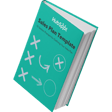How much of today’s well-intended sales “enablement” actually enables seller productivity? The answer is both surprising and frustrating.
At CEB, now Gartner, we often refer to today’s sales environment as “The World of More,” spanning more people, priorities, perspectives, processes, and procedures than ever before. All translating to increased “seller burden” as reps struggle to simultaneously manage greater solutions complexity, organizational coordination, and customer dysfunction.
Sales leaders often tell us they’re looking for a “quarterback" or “general manager” more than a traditional seller -- someone who’s can both sell effectively and manage all those different flavors of “more.” Because all of this “more” is killing productivity.
So how do we decrease seller burden in the World of More? Typically, the answer is: More help. In fact, lots of help.
If reps struggle with product knowledge or solutions integration, we add sales engineers and additional marketing collateral. If they struggle to design profitable solutions, we set up deal desks, legal support teams, cross-silo integration protocols, executive sponsors, and additional subject matter experts. If reps struggle to understand customer issues and opportunities, we provide technology and tools to integrate data, offer guidance, create connections, tailor talking points, and even suggest next steps. The list of modern-day enablement opportunities is seemingly infinite.
A recent survey from CEB, now Gartner, found 98% of senior sales leaders were investing more in sales enablement resources than in previous years. And our hundreds of interviews with sales leader tell us the same thing. We’re fighting “more” with more. All with the best of intentions, of course: To boost rep productivity and increase sales.
But many reps find this “support” far less helpful than leaders intended. Three in four of the 2,000-plus B2B sellers said increased sales support wasn’t reducing complexity, but increasing it.
From a rep’s perspective, the very thing designed to make selling easier has made it harder -- a phenomenon especially frustrating to sales enablement executives that are bombarded nearly every day by front-line seller requests for “better tools” and “more help” because the resources they’ve been provided so far “aren’t really what we need.”
But if we were to look at things through the reps’ eyes, it’s no wonder they’re frustrated. Have you ever stopped to calculate all of the “support touchpoints” your reps must typically navigate in any given month simply to do their job? We have. And it’s eye-opening.
To find your own number, simply multiply the number of opportunities an average rep in your organization pursues in a month by the number of internal stakeholder interactions each opportunity typically requires (e.g. two meetings with specialists, one with a sales engineer, two with legal, one with finance, two with implementation teams, and so on).
Separately, multiply that same number of monthly opportunities by the number of different tools, websites, systems, platforms, databases, and apps your reps typically consult across a given opportunity. Then take those two results and add them together. That result will help you approximate the total number of internal touchpoints sellers normally encounter every month.
For most companies, the result ranges from the mid-hundreds to well over one thousand. Indeed, when you first see it, the number seems impossibly high. But stop and think about all of the internal people and systems sellers must touch every day (in person, through email, on CRM, over the internet) simply to do their job. Some of those interactions may be very brief, even easy -- but there are a lot of them. And if we think about those touchpoints less in terms of time and more in the mental energy necessary to shift from resource to resource across one opportunity to the next, all in a typical day, it’s exhausting.
This is what happens when we support sales in the World of More with yet even more. And the potential costs are huge.
We modeled the potential drop in sales conversion rate created by the burden associated with high levels of internal complexity. Controlling for both individual and organizational differences, sellers working in high burden organizations have a 12% lower conversion rate.
That loss stems from two underlying problems. First, reps in high-complexity organizations simply get less done -- and less sold -- in the same amount of time. They're slowed down by an inefficient organization.
Second, high seller burden harms motivation. All that coordination, navigation, complication, and frustration often leads reps to simply give up or check out. Instead of coming to work every day ready to do battle, they’re simply muddling through the next hour, looking to survive another day of defeat, working for an organization that seems to “just not get it.”
Seller burden, in other words, isn’t just unproductive, it’s actually counterproductive. Far beyond failing to boost productivity and value, complexity actually destroys it. It prevents a sales organization from reaching even a neutral level of performance, let alone maximum productivity. And that counterproductive impact translates to direct and indirect costs in terms of time, money, resources, talent, retention, effort, morale, you name it. Let alone the opportunity cost of the 12% of business that failed to convert.
And yet, it was all done with such good intentions -- to better support the complex sale.
How do we decrease seller burden while simultaneously pursuing increasingly complex sales? The answer isn’t to do more. It’s actually to do less. A lot less, in fact. It’s a solution we call “Ruthless Simplicity.” And we’ll dive into that in the next post.
Until then, we all have that experience of providing reps with support only to find that they “still want more” or it’s “not really what we need.”







![The 5 Pivotal Stages of Sales Maturity [Quiz]](https://53.fs1.hubspotusercontent-na1.net/hubfs/53/sales-maturity-model%20%281%29-1.jpg)



![What Does a Sales Enablement Professional Do? [+ Template Job Description]](http://53.fs1.hubspotusercontent-na1.net/hub/53/file-2053853365-jpeg/climbers.jpeg)